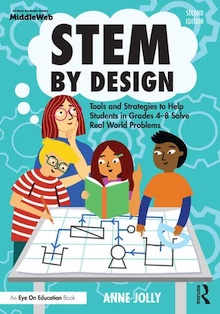STEM By Design: Tools and Strategies to Help Students in Grades 4-8 Solve Real World Problems, Second Edition
By Anne Jolly
(Routledge/Eye On Education, 2025 – Learn more)
Reviewed by Heidi Braden
 STEM by Design by Anne Jolly is a helpful and inspiring read for any middle school science teacher. It’s particularly valuable for educators who are new to STEM instruction or those looking for a refresher as they begin to implement STEM projects with students.
STEM by Design by Anne Jolly is a helpful and inspiring read for any middle school science teacher. It’s particularly valuable for educators who are new to STEM instruction or those looking for a refresher as they begin to implement STEM projects with students.
Jolly, a veteran of STEM curriculum design, has created a well-organized and practical resource, complemented by a companion website. This website is especially useful because it offers downloadable versions of all the design tools featured in the book, along with access to free resources, the author’s blog, and a discussion guide for book studies or professional learning communities.
 The book begins by clarifying what STEM is, and just as importantly, what it is not. The term “STEM project” is sometimes loosely or wrongly applied in educational settings, and this clarified foundation is essential at the start of the book. Jolly clearly outlines the key components that define an authentic STEM experience and explains why engaging students in these types of well-structured lessons is so critical for their success in both deep learning and in the real world.
The book begins by clarifying what STEM is, and just as importantly, what it is not. The term “STEM project” is sometimes loosely or wrongly applied in educational settings, and this clarified foundation is essential at the start of the book. Jolly clearly outlines the key components that define an authentic STEM experience and explains why engaging students in these types of well-structured lessons is so critical for their success in both deep learning and in the real world.
After clearly describing what a well-structured STEM lesson includes, the book walks educators through the steps of designing a STEM project. The author does this by using guiding questions and concrete examples to support the lesson design process. She discusses where teachers can find STEM project ideas and how to choose relevant, real-world problems for students to tackle.
Jolly then goes on to explore how to effectively prepare students for STEM work and how to successfully guide their experience during the project. Jolly offers strategies for teaching the Engineering Design Process, promoting collaboration, integrating technology, and assessing student learning.
What I Enjoyed Most
Design Tools in Every Chapter: The book includes numerous design tools that teachers can use either for their own planning or directly with students. These tools are also available on the companion website, making them easy to access and print.
Teaching Tips: The author has interspersed teaching tips throughout the book. They are short, straightforward tips meant to give advice and insight as a teacher plans a STEM project.
Real Classroom Examples: The author has included several examples of challenges or successes that real students and teachers have encountered when working through STEM projects. These examples made the content relatable and helped me envision the concepts being discussed.
Resource & Appendix Sections: The final sections of the book are packed with additional resources, including URLs and QR codes that link to further learning. The appendices also feature extended insights from the author on related STEM education topics.
Overall, STEM by Design is an accessible and worthwhile read you’ll want to keep handy throughout the year. It’s clearly written and full of actionable advice. Whether you’re just beginning your STEM journey or looking to deepen your practice, this book is a practical guide to designing effective STEM experiences in the middle school classroom.
Heidi Braden is an educator with 24 years of teaching experience in the middle school setting, mainly in the Science and ELA subject areas. She has taught in both traditional and virtual classrooms. She is currently serving as a middle grade science teacher at a virtual charter school, and loving every minute of it. She strives to foster curiosity and academic growth through engaging, standards-based instruction.


